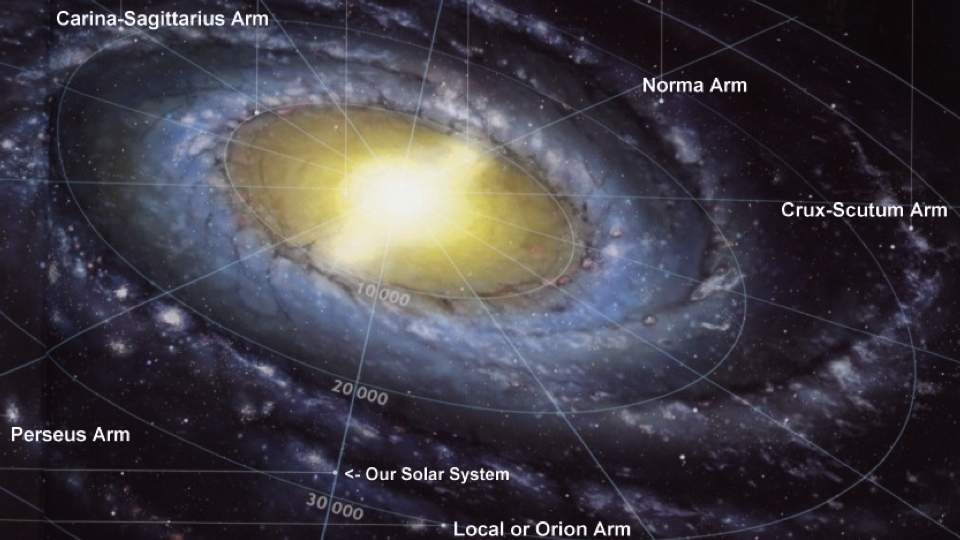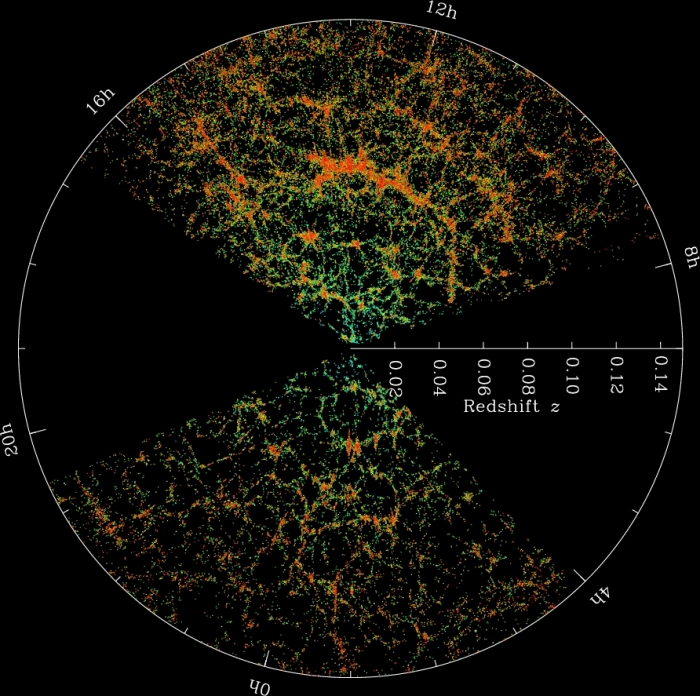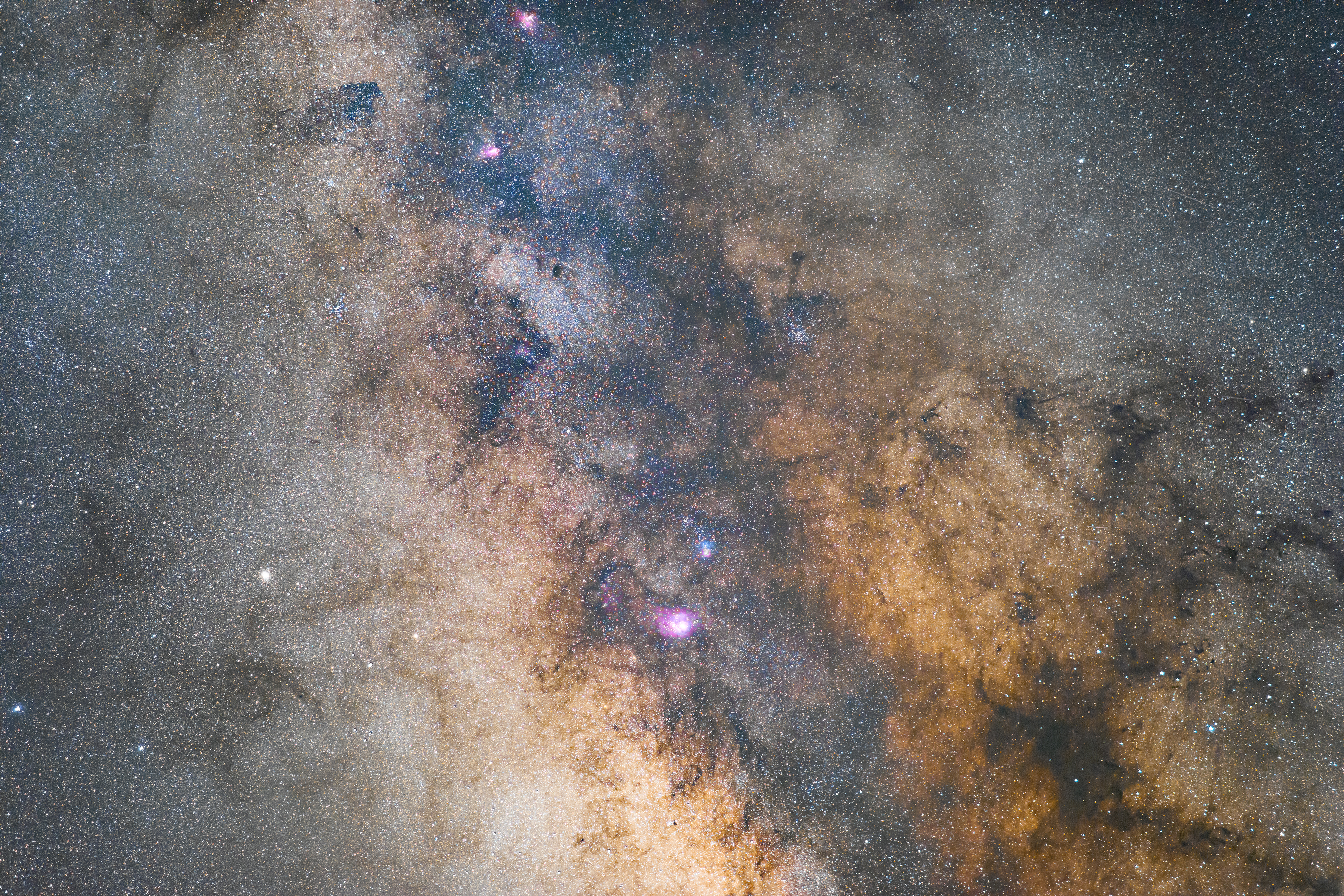The Milky Way. If Earth is our home and the solar system is our suburban neighborhood (located in a part of town called the Orion Arm or Orion Spur), the Milky Way Galaxy is the metropolis of which our suburb is a part. We have always lived in the suburb of this large city. We always will. Like a midwestern girl destined to take over her family's small-town business, we have always been here and it's more than likely we will never leave. It's unlikely we will ever visit downtown, much less get out to see other big cities.
Let's suppose that girl, let's call her Astrid, decides she does want to leave her home town and even wants to get out beyond the big city.
Traveling outside the big city isn't a matter of will or desire for Astrid. Money isn't the problem. She has transportation — the fastest car on the planet — the roads are in great shape and the cops will give her a pass and let her go as fast as her car can go. None of that matters because those aren't the issues. Physics and distances are the issues.
If Astrid could travel at the speed of light (about 186,000 miles per second), it would take her over 100,000 years to get from one edge of the urban sprawl to the other, making a straight line through downtown. That's with no traffic, no construction, no stop lights or stop signs, and a truly straight road. One-hundred thousand years just to travel from one side to the other. The distances are just too vast for us to ever leave our town, much less to ever escape the bigger city. Suppose instead of heading through downtown to the other side of town, she goes in the opposite direction, away from downtown, to visit the next city over. Well, she's looking at about 2 million years for that road trip. And that's if she was traveling at the speed of light, which she isn't and can't. She can't even get close to that speed.
Wormholes may exist in nature but probably only on the quantum scale and for nanoseconds at a time. Traveling at the speed of light or creating an artificial wormhole for human-scale travel, assuming Astrid could even physically survive any such journey, requires an amount of energy that can only be approximated as... infinite. Not gonna happen.
Current understanding of the relative nature of space and time suggests that, if Astrid could travel at 0.99999999999999 c (very, very close to the speed of light), she could traverse the galaxy's diameter in about 6 days from her perspective of time. But 100,000+ years will have passed on Earth... and from the perspective of anyone on Earth, another 100,000+ years will pass by the time Astrid returns. She will have felt like she was traveling for a couple weeks but with over 200,000 years passing on Earth, to whom and what would Astrid return? Will there be anyone to greet her? If so, will anyone believe her story of space and time travel?
This is why science and the studies of astronomy, cosmology, astrophysics and quantum physics/mechanics are so critically important if we are to ever understand anything outside ourselves. Our bodies will never be able to travel these unimaginably vast distances. But the electromagnetic spectrum carries enormous amounts of information throughout the universe at the speed of light (after all, UV, infrared, radio, gamma... it's all part of the same spectrum that also contains what we know as visible light). We now know that gravity carries information too—information about cataclysmic events like merging black holes. We must be able to detect and decipher this constant stream of information.
It has been said that the universe has created a way for it to understand itself... us. Maybe anthropomorphizing the universe isn't the best approach, and the word "created" has some sketchy implications. But it's a wonderful way to conceptualize the evolution of energy to matter to life to consciousness to reasoning and to understanding and imagining. Maybe that's the ultimate state of the universe... not energy and matter but consciousness and understanding.
Stuck circling one star in our location in one galaxy among billions, astronomers have still found a way to map the galaxy and the universe—not easy tasks. Imagine if Astrid, realizing her travel limitations are insurmountable, decides instead to map the large metropolis she lives near including all of its suburbs and downtown. She wants to identify the basic structure but also accurately locate major buildings, landmarks and areas like parks and bodies of water. Her goal is to create an illustration detailing everything to scale with proper positions and distances. The thing is, she is restricted to standing in one spot with little more than a small spotting scope. While she can look in any direction to survey her surroundings, she cannot move from her spot by more than a few inches. And her single viewpoint isn't even elevated nor is it in the center of this city.
With all those restrictions and limitations you might be thinking, "You just described the challenges of my actual job. So what?"
Astrid not only needs an excellent spotting scope (the Hubble Telescope), she needs something even better to see through buildings and haze (the Spitzer Space Telescope), and she needs something better still if she's going to identify anything other than structures more than several square blocks in size (the James Webb Space Telescope).
Assuming she's successful in this seemingly impossible task, to explain why everything she sees appears as it does and to describe why it interacts the way it does, explaining gravity, light, and baryonic/leptonic matter ain't going to cut it. She needs to detect and explain things she can't currently detect or explain... dark matter and dark energy. This is the task of astronomers, cosmologists, and theoretical mathematicians of today.
Get under a dark sky this summer. See the Milky Way. While looking at it, imagine you are Astrid. Feel small and helpless by your limitations. But feel bold and empowered knowing that you are a part of what the universe brought forth in order to understand itself. You ARE part of a grand evolutionary journey.
Let's suppose that girl, let's call her Astrid, decides she does want to leave her home town and even wants to get out beyond the big city.
Traveling outside the big city isn't a matter of will or desire for Astrid. Money isn't the problem. She has transportation — the fastest car on the planet — the roads are in great shape and the cops will give her a pass and let her go as fast as her car can go. None of that matters because those aren't the issues. Physics and distances are the issues.
If Astrid could travel at the speed of light (about 186,000 miles per second), it would take her over 100,000 years to get from one edge of the urban sprawl to the other, making a straight line through downtown. That's with no traffic, no construction, no stop lights or stop signs, and a truly straight road. One-hundred thousand years just to travel from one side to the other. The distances are just too vast for us to ever leave our town, much less to ever escape the bigger city. Suppose instead of heading through downtown to the other side of town, she goes in the opposite direction, away from downtown, to visit the next city over. Well, she's looking at about 2 million years for that road trip. And that's if she was traveling at the speed of light, which she isn't and can't. She can't even get close to that speed.
Wormholes may exist in nature but probably only on the quantum scale and for nanoseconds at a time. Traveling at the speed of light or creating an artificial wormhole for human-scale travel, assuming Astrid could even physically survive any such journey, requires an amount of energy that can only be approximated as... infinite. Not gonna happen.
Current understanding of the relative nature of space and time suggests that, if Astrid could travel at 0.99999999999999 c (very, very close to the speed of light), she could traverse the galaxy's diameter in about 6 days from her perspective of time. But 100,000+ years will have passed on Earth... and from the perspective of anyone on Earth, another 100,000+ years will pass by the time Astrid returns. She will have felt like she was traveling for a couple weeks but with over 200,000 years passing on Earth, to whom and what would Astrid return? Will there be anyone to greet her? If so, will anyone believe her story of space and time travel?
This is why science and the studies of astronomy, cosmology, astrophysics and quantum physics/mechanics are so critically important if we are to ever understand anything outside ourselves. Our bodies will never be able to travel these unimaginably vast distances. But the electromagnetic spectrum carries enormous amounts of information throughout the universe at the speed of light (after all, UV, infrared, radio, gamma... it's all part of the same spectrum that also contains what we know as visible light). We now know that gravity carries information too—information about cataclysmic events like merging black holes. We must be able to detect and decipher this constant stream of information.
 |
| This is what the Milky Way Galaxy might look like if you were able to get 2 million light years away from it. This is our galactic neighbor, M31, the Andromeda Galaxy. Photo by Daniel Perry. |
It has been said that the universe has created a way for it to understand itself... us. Maybe anthropomorphizing the universe isn't the best approach, and the word "created" has some sketchy implications. But it's a wonderful way to conceptualize the evolution of energy to matter to life to consciousness to reasoning and to understanding and imagining. Maybe that's the ultimate state of the universe... not energy and matter but consciousness and understanding.
Stuck circling one star in our location in one galaxy among billions, astronomers have still found a way to map the galaxy and the universe—not easy tasks. Imagine if Astrid, realizing her travel limitations are insurmountable, decides instead to map the large metropolis she lives near including all of its suburbs and downtown. She wants to identify the basic structure but also accurately locate major buildings, landmarks and areas like parks and bodies of water. Her goal is to create an illustration detailing everything to scale with proper positions and distances. The thing is, she is restricted to standing in one spot with little more than a small spotting scope. While she can look in any direction to survey her surroundings, she cannot move from her spot by more than a few inches. And her single viewpoint isn't even elevated nor is it in the center of this city.
With all those restrictions and limitations you might be thinking, "You just described the challenges of my actual job. So what?"
 |
| An illustration of what the Milky Way might look like to an outside observer with spiral arms and distances from the center marked (in light years). |
Astrid not only needs an excellent spotting scope (the Hubble Telescope), she needs something even better to see through buildings and haze (the Spitzer Space Telescope), and she needs something better still if she's going to identify anything other than structures more than several square blocks in size (the James Webb Space Telescope).
 |
| A map showing the basic structure and distribution of matter in our area of the universe. http://www.e-education.psu.edu/astro801/content/l10_p6.html |
Assuming she's successful in this seemingly impossible task, to explain why everything she sees appears as it does and to describe why it interacts the way it does, explaining gravity, light, and baryonic/leptonic matter ain't going to cut it. She needs to detect and explain things she can't currently detect or explain... dark matter and dark energy. This is the task of astronomers, cosmologists, and theoretical mathematicians of today.
Get under a dark sky this summer. See the Milky Way. While looking at it, imagine you are Astrid. Feel small and helpless by your limitations. But feel bold and empowered knowing that you are a part of what the universe brought forth in order to understand itself. You ARE part of a grand evolutionary journey.


Comments
Post a Comment